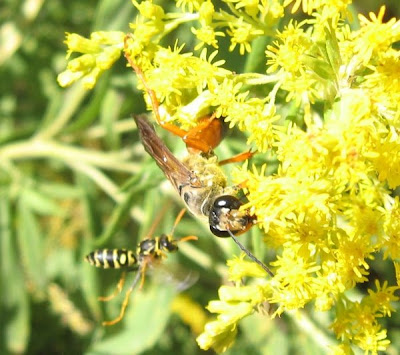Actually, not so tangled, and not all spiders spin webs. A spider is guided by instinct in building a web characteristic of its species. The webs are marvels of geometry ... it seems that no matter where we look, mathematics is "hardwired" into the universe.
The orb weaver snacking on the hapless hoverfly in the first three photos looks like a Shamrock Spider (Araneus trifolium). The coloration of this spider is highly variable and some individuals are nearly white. This female had a nest above its web made of rolled up leaves held together with silk. A line connected the redoubt and the web, transmitting vibrations to alert the spider to the presence of prey snared in its net.



Mangora gibberosa ... same spider as in an earlier post.

The same Long Jawed Orb Weaver (Tetragnatha sp.) as in the last post. Despite its limited vision the spider was very well aware of my presence ...

An immature Flower Spider (Misumena sp.), this specimen is approximately one third the size of an adult.

A different species of Crab Spider. It was windy, making it difficult to capture details (especially the eyes), my best guess based on this sole out of focus image is Xysticus sp.

An immature Cross Spider (Araneus diadematus).


The following picture is the ventral view of an adult female Cross Spider. It's hard to judge the scale from a photo ... this spider is actually twice the size of the spider in the two pictures above.

A dorsal view of the adult female Cross Spider seen above.

The next three photos show an adult male Cross Spider. Male spiders deliver their sperm with their pedipalps and the customized organs can clearly be seen in the lateral and dorsal views of the spider.



Female Funnel Weaver Spider, Agelenopsis sp.

This is the smaller Agelenopsis sp. male

A female Nursery Web Spider, Pisaurina mira. Judging by the pale color this one looks like it has molted recently.


Since I caught it in the act of making its web, it's probably safe to say the spider in the next two pictures is an orb weaver. The photos were taken at night against a green background so the quality of the images leaves something to be desired (some of the green was removed and the images sharpened after being downloaded to the hard drive). Some of the orb weavers can be hard to identify even from a good image, based on the information at hand I'm going to go with Larinioides sp. , most likely Larinioides sclopetarius.


The spider in the next picture is a male Larinioides sp., note the large modified pedipalps (he also seems to have misplaced a leg). Male and female spiders appear so different from one another that sometimes it's hard to believe they are the same species.




























































